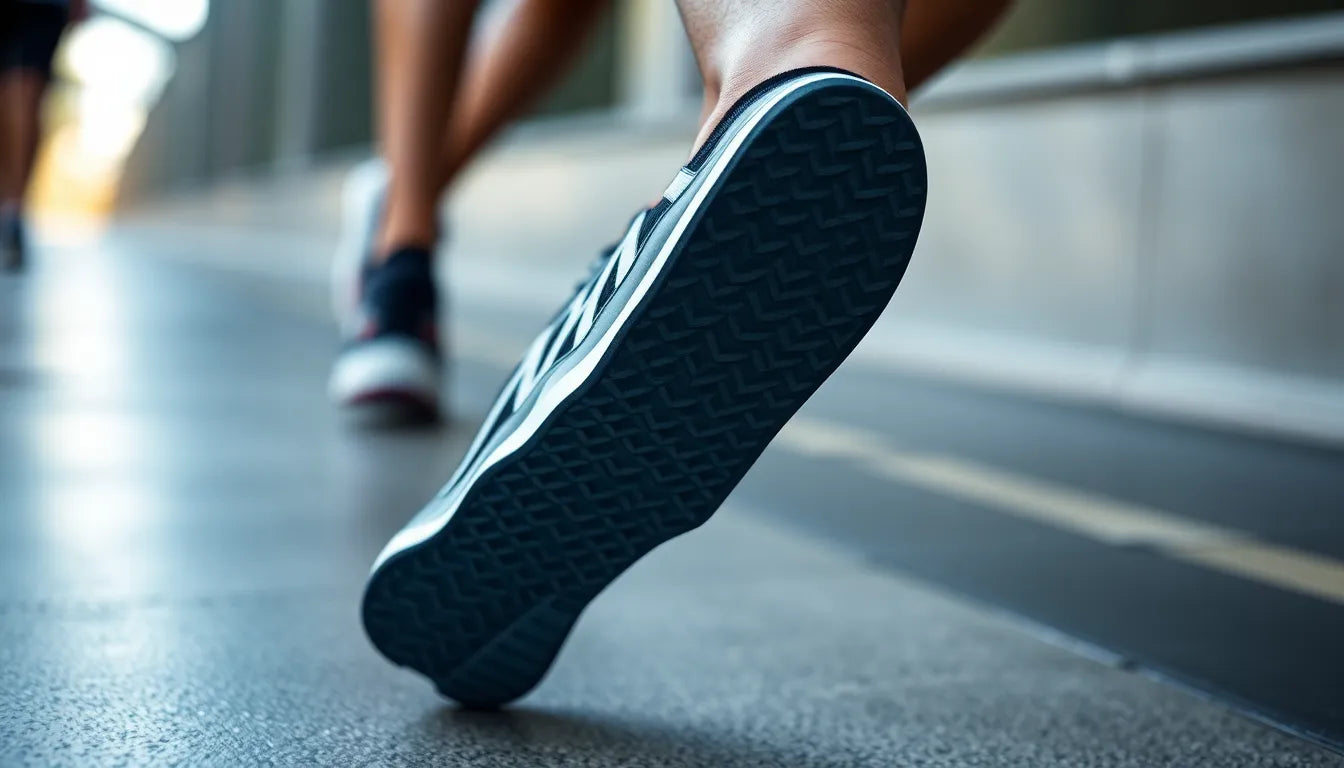Knee pain is a common ailment among runners, often referred to as "løberknæ" or runner's knee. This condition can turn a passion for running into a painful experience, making it crucial to address the underlying causes. One of the most significant factors influencing knee health is the choice of running shoes. Selecting the right pair can prevent and alleviate knee pain, allowing you to enjoy your runs without discomfort.
understanding the connection between running shoes and knee pain
The link between running shoes and knee pain lies in biomechanics and repetitive strain. Poorly fitted or unsuitable running shoes can lead to improper alignment and inadequate impact absorption, exacerbating knee issues. When the foot strikes the ground, the force travels up through the legs, affecting the knees. If the shoes don't provide the necessary support and cushioning, the knees bear the brunt of this impact, leading to pain and potential injury.
the prevalence of runner's knee
Runner's knee is a prevalent condition affecting many athletes, characterized by pain around the kneecap. This pain often worsens during running, descending stairs, or after periods of inactivity. Symptoms include discomfort outside or around the kneecap, which can significantly impact a runner's performance and motivation. Understanding these symptoms is the first step in addressing the issue and finding solutions that work.
key risk factors for knee pain
Several risk factors contribute to knee pain, including sudden increases in running distance, muscular weakness, poor running technique, and flat feet. These factors can lead to increased strain on the knees, highlighting the importance of proper footwear. The right running shoes can help mitigate these risks by providing the necessary support and stability, ensuring that your knees are protected during every run.
As we delve deeper into the topic, we'll explore how the right footwear can play a pivotal role in preventing knee pain and enhancing your running experience. Stay tuned for practical advice and insights into choosing the perfect running shoes tailored to your needs.
medical and scientific insights on runner's knee
Runner's knee, or "løberknæ," is a common condition that arises from inflammation or irritation due to repetitive strain. This condition primarily affects the area around the kneecap, leading to discomfort and pain. The biomechanics of running play a crucial role in the development of runner's knee. When running shoes fail to provide proper alignment and impact absorption, the stress on the knee joint increases. This misalignment can exacerbate existing issues and lead to further complications. Understanding these biomechanical factors is essential in preventing and managing knee pain effectively.
prevention strategies through proper footwear
The role of running shoes in injury prevention cannot be overstated. Selecting the right footwear is pivotal in minimizing the risk of knee pain. Key features to look for in running shoes include:
- Good lateral support: Ensures stability during movement, reducing the risk of twisting or straining the knee.
- Stable heel cups: Provide a firm grip around the heel, enhancing stability and preventing excessive foot movement.
- Appropriate forefoot flexibility: Allows for natural foot movement and reduces strain on the knee joint.
- Sufficient cushioning: Absorbs shock and reduces the impact on the knees, especially during longer runs.
By focusing on these features, runners can significantly reduce the likelihood of developing knee pain and improve their overall running experience.
the role of orthopedic insoles
Orthopedic insoles can be a game-changer for individuals with biomechanical issues such as overpronation or flat feet. These custom insoles provide additional support and alignment, ensuring that the foot strikes the ground in a more balanced manner. By correcting these biomechanical discrepancies, orthopedic insoles can help alleviate knee pain and prevent further injury. They are versatile and can be used in both running and everyday shoes, making them a practical solution for continuous support.
additional preventive measures
In addition to choosing the right running shoes, several other strategies can help prevent knee pain. Runners should be cautious not to increase their running distance too quickly, as this can lead to overuse injuries. Alternating running surfaces can also distribute stress more evenly across the body, reducing the risk of knee pain.
Focusing on proper running technique is crucial. This includes maintaining a good posture, ensuring the knees are aligned with the feet, and avoiding overstriding. Strength training and stretching exercises are also vital components of a comprehensive prevention strategy. Strengthening the muscles around the knee and hip can enhance stability and reduce the risk of injury, while stretching can improve flexibility and reduce muscle tension.

Women's Posture Shirt™ - Black
Patented shirt: improves posture, relieves pain and tension, and increases muscle activation.
By integrating these preventive measures with the right footwear, runners can enjoy their sport with reduced risk of knee pain and improved performance. In the next section, we will explore treatment recommendations for those already experiencing runner's knee, along with commercial considerations and frequently asked questions.
treatment recommendations for runner's knee
Addressing runner's knee requires a holistic approach that combines professional treatment with self-care strategies. Professional interventions may include manual therapy, which helps improve joint mobility and reduce pain. Individualized exercise programs can also be beneficial, focusing on strengthening the muscles around the knee and enhancing flexibility. In some cases, advanced therapies such as shockwave or laser therapy might be recommended to promote healing.
Self-care is equally important. Resting and avoiding activities that aggravate the knee can prevent further damage. Applying ice to the affected area can reduce inflammation and pain. When returning to activity, it is crucial to do so gradually to avoid re-injury. Seeking a professional evaluation from a physiotherapist or healthcare provider can provide a tailored treatment plan that addresses specific needs and underlying causes.
commercial and product considerations
When it comes to selecting the right running shoes, commercial advice often emphasizes the importance of choosing equipment that aligns with individual biomechanics. This means considering factors like foot arch, pronation, and personal comfort preferences. Softly introducing products like Anodyne’s ergonomic insoles can be part of a broader, evidence-based solution for those seeking additional support. These insoles are designed to provide enhanced stability and alignment, which can be crucial for preventing and managing knee pain.
frequently asked questions
what are the signs that my knee pain is related to my running shoes?
Signs that your knee pain might be related to your running shoes include uneven wear patterns on the soles, a lack of support or cushioning, and experiencing discomfort or pain during or after running. If your shoes are not providing adequate support, it may lead to improper alignment and increased strain on the knees.
how often should I replace my running shoes to prevent knee pain?
It is generally recommended to replace running shoes every 300 to 500 miles, depending on your running style, body weight, and the surfaces you run on. Additionally, if you notice signs of wear or a decrease in cushioning and support, it may be time to invest in a new pair to prevent knee pain.
can I run with knee pain, or should I rest?
If you experience knee pain, it's advisable to rest and avoid activities that exacerbate the discomfort. Continuing to run despite pain can lead to further injury. Once the pain subsides, you can gradually return to running, ensuring to incorporate modifications and proper techniques to prevent recurrence.
are there specific exercises that can help prevent runner's knee?
Yes, exercises that focus on strengthening the muscles around the knee and hips can help prevent runner's knee. These include squats, lunges, and leg raises, which improve muscle stability and support the knee joint. Incorporating flexibility exercises such as stretching can also be beneficial.
how can I choose the right running shoes for my foot type?
To choose the right running shoes, first determine your foot type by assessing your arch and pronation. Many specialty running stores offer gait analysis services to help identify your specific needs. Based on this assessment, select shoes that provide the appropriate level of support, cushioning, and stability for your foot type.

Men's Posture Shirt™ - White
Men’s patented shirt with NeuroBand™: supports muscles, relieves pain, and improves posture.


















